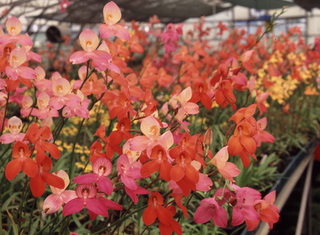|
Culture Tips
Disas are terrestrial orchids which grow on Table Mountain in South Africa.
The conditions which they experience in the wild are quite harsh and this
gives the clue as to how they should be cultivated. In nature they grow by
streams and in seepage areas with their roots in water and are constantly
wet.
We grow our disas in pots which we stand in gravel trays filled with
rainwater. They are potted in a compost of 60% coarse peat and 40%
super coarse perlite, although we have also had good results with live
sphagnum moss and even moss collected from the greenhouse gutters.
Disas do not seem to like being potted in rockwool!
Water quality is vitally important and we only use rainwater on our
plants. They will not tolerate hard or chlorinated water. Watering is done
from the top of the pots and is poured through the compost until the
gravel trays overflow.
Feeding is best done little and often with a very dilute solution being
added, into the trays and NOT into the pots, at regular intervals when the
plants are growing. Do not overfeed, as Disas will not tolerate high
salt levels and will die!
Disas will tolerate quite a range of temperatures and will be quite happy in
a frost free greenhouse. They need to be kept as cool as possible in summer
and shading should be applied to the glass. In very bright conditions the
leaves will be pale and yellow but the colour of the flowers will be better - a
compromise is required.
Flowers should appear in late spring into summer, but can be temperamental
in some clones and no guarantee can be given that a plant will flower.
 After flowering the stem and the old plant will start to die back and turn
yellow and then brown. This is quite natural as the plant is recycling
nutrients back into the tuber to help next years growth. After flowering the stem and the old plant will start to die back and turn
yellow and then brown. This is quite natural as the plant is recycling
nutrients back into the tuber to help next years growth.
At about the same time or sometimes later new growths will be seen to
appear from stolons arising from the old plant. When these are large
enough, usually in late September to October, they can be taken from the
old plant and potted separately. The old plant should be discarded. Any
leaves which show signs of botrytis or fungal growth should be taken off the
plant and destroyed. Fungal diseases can be fatal to Disa plants and the
best first aid is to repot into fresh compost. Hygiene is very important, as
well as good air movement.
We hope that you enjoy growing these spectacular orchids and that they
give you as much pleasure as they have given us!
Thank you for your custom and please do not hesitate to contact us with any
queries with which we may be able to help you.
We are concerned by the number of our customers, who are being wrongly advised with regard to growing media for Disas.
Disas do not like Orchid compost or Orchid bark. We have had no success coir peat substitutes, and certainly not potting compost.
An open media, that holds some moisture, has airspace, very low fertiliser very low salt levels is needed.
We find that peat/perlite makes all chopped sphagnum moss with perlite added give the best results.
Dave Parkinson
|